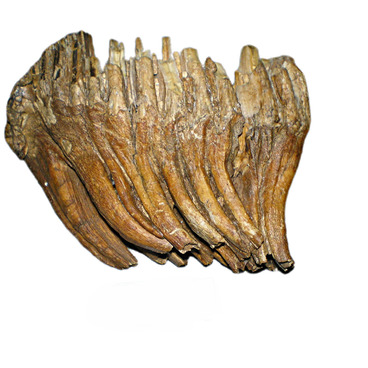A fragment of a bison skull with a horn
Horns are bony structures firmly connected to the skull, almost always only one pair.
The skull consists of a partially preserved occipital bone with an articular process. The horn is almost completely preserved, slightly broken off at the end. A bone labyrinth is visible inside the skull.
Bison are huge three—meter bulls. The history of bison has been known since the late Pliocene, about one and a half million years before our days.
The largest — long-horned bison appeared 200-100 thousand years ago on the territory of Siberia. Mature males reached a height of more than 2 meters, with a body length of more than 3 meters and weighed 2-2.5 tons. The bison’s head was crowned on both sides by huge, slightly curved horns.
With such a size and weight, bison were still very mobile animals. They had a muscular lean body covered with coarse brownish fur, and long legs on wide hooves. The primitive bison could probably reach speeds of up to 40-50 km per hour.
The bison had practically no natural enemies, no predator risked attacking such a giant alone, so their numbers grew rapidly. Bison are typical inhabitants of the cold steppes of the glacial era. The basis of their nutritious diet was dry steppe grasses.
In cold snowy winters, bison grazed in open, wind-blown areas, foraging from under the snow, or entered coastal areas of the forest, feeding there on shrub shoots.
With the onset of warming about 10 thousand years ago, bison in Siberia began to die out and gradually disappeared.
Horns are bony structures firmly connected to the skull, almost always only one pair.
The skull consists of a partially preserved occipital bone with an articular process. The horn is almost completely preserved, slightly broken off at the end. A bone labyrinth is visible inside the skull.
Bison are huge three—meter bulls. The history of bison has been known since the late Pliocene, about one and a half million years before our days.
The largest — long-horned bison appeared 200-100 thousand years ago on the territory of Siberia. Mature males reached a height of more than 2 meters, with a body length of more than 3 meters and weighed 2-2.5 tons. The bison’s head was crowned on both sides by huge, slightly curved horns.
With such a size and weight, bison were still very mobile animals. They had a muscular lean body covered with coarse brownish fur, and long legs on wide hooves. The primitive bison could probably reach speeds of up to 40-50 km per hour.
The bison had practically no natural enemies, no predator risked attacking such a giant alone, so their numbers grew rapidly. Bison are typical inhabitants of the cold steppes of the glacial era. The basis of their nutritious diet was dry steppe grasses.
In cold snowy winters, bison grazed in open, wind-blown areas, foraging from under the snow, or entered coastal areas of the forest, feeding there on shrub shoots.
With the onset of warming about 10 thousand years ago, bison in Siberia began to die out and gradually disappeared.


